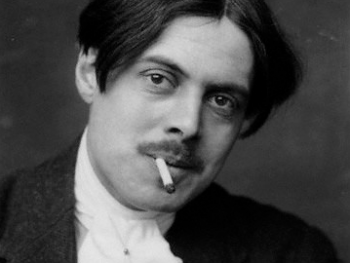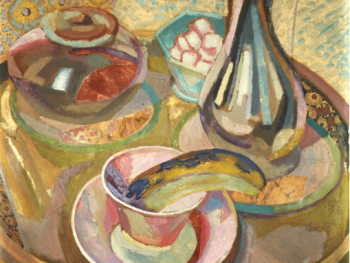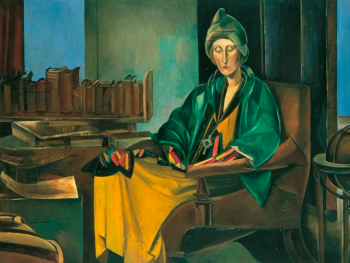Dave Eggers, Wyndham Lewis and Hate

Wyndham Lewis was the coming man in 1913. Rich parents, Rugby, Slade School, knocked around Paris, talented writer and painter, good-lookin’, etc.
Already he’d been published by Ford Madox Ford in The English Review and shown paintings with Jack the Ripper obsessive Walter Sickert. He also had three paintings in the second Post-Impressionist exhibition with Roger Fry and Clive Bell, members of the Bloomsbury Group. Almost all of those Bloomsbury guys were very what we used to call “fabulous,” by which I mean arch, conceited, clever, stylish, discontented and self-regarding (21st-century virtues all).
Roger Fry set up a design studio, the Omega Workshop, and Wyndham Lewis worked there for awhile. But in 1913, after the two of them got into a massive fight, Lewis left in a huff with a bunch of his friends (including Jacob Epstein, Henri Gaudier-Brzeska and Dorothy Shakespear) to form the Vorticist group. These Vorticists (so dubbed by Ezra Pound) combined elements of Cubism, Futurism and Dada, and were reckoned to be super tough and modern.
Unsurprisingly, the Vorticists were shown no love by the Bloomsburys who, aside from having gotten into a huge spat with Lewis, were much preferring to affect the relatively effete style and manners of the sophisticated Fauves over there in France, where the food was better and they were less troglodytic, I guess they thought. Robert Hughes wrote: “In 1917 [Clive] Bell sneered at the ‘new spirit in the little backwater, called English Vorticism, which already gives signs of being as insipid as any other puddle of provincialism.’”
Speaking of provincial puddles, though, the Matisse ’n’ Cezanne-inspired works of the Bloomsburys tended to be totally derivative, and also kind of limp and watery:

Whereas the contemporaneous canvases of Wyndham Lewis were full of Pow.

Decades later, the energy and originality of Wyndham Lewis and his cohort became very much admired, maybe more so than any of the Bloomsbury painters (who had better luck with their writers, obviously, so that the painters got some traction that way.)
Part of the reason it took so long for the Vorticists to come into their own is that Wyndham Lewis was a very questionable specimen. Lot of things to dislike about this guy. He was wildly anti-Semitic; he even managed to write a whole book in favor of Hitler in 1931 (Hitler, it is called.) The man just shot his mouth off like crazy. As you can imagine, Lewis felt pretty bad when he found out what was actually going down in Nazi Germany when he went to Berlin in 1937! So he took it all back, which is at least something. (His idea of contrition was to write a book called The Jews: Are they Human?, in 1939.) Wilde’s friend Robbie Ross called Lewis “a buffalo in wolf’s clothing.”
All this brings me to Dave Eggers, you may be surprised to hear. Dave Eggers, though evidently not an openly combative or buffalo-like person, is like Lewis in being both talented and roundly disliked; an outsider in his own circle.
Dave Eggers is a thorn in many a side in today’s America, my own included. His bizarre combination of fame, enthusiasm and sentimentalizing drives a lot of people up a tree. It’s safe to say that Eggers is currently the most detested man in American haute-literary circles. To support this contention, I’ve made a table of Google searches using the phrase “I hate _________,” and put in a lot of divisive-seeming haute-literary names.
Mary Karr: 0
Donna Tartt: 0
Ben Kunkel: 0
Marisha Pessl: 1
Ayelet Waldman: 1
Jonathan Franzen: 2
Michael Chabon: 2
Richard Powers: 2
Joan Didion: 4
Elizabeth Wurtzel: 89
Zadie Smith: 102
Jonathan Safran Foer: 120
Rick Moody: 374
David Sedaris: 774
Dave Eggers: 3880
To which I say: ??!? Of course this is a far from scientific method of figuring such stuff out, but I should never have supposed that zero people on the Internet are currently saying straight up that they hate Mary Karr, who has been very much in the newspapers, when Dave Eggers is experiencing almost four thousand times the virtual hate. (An aside. If you’d like a hint as to how very small the literary corner of the world of letters is, consider that even Eggers is well behind David Brooks (5,090) and nowhere near the political mahoola, Maureen Dowd-who, at the time of this writing, is at 9,550 hate-points. “I hate George Bush”? That one has got over 1.7 million hits and its own Facebook group. Despite the Teabaggers’ best efforts, our current President is only scoring a measly 465,000. Give it time.)
Part of the hate accruing to Dave Eggers is undoubtedly due to crab-bucket syndrome, which is when there are a lot of rivals, e.g., writers who are struggling after success in the form of TED prizes and screenplay commissions, and then one of them actually succeeds, and the rest of his fellow-strivers and former comrades attempt to yank him back down again. In the case of Eggers this is commonly depicted as not just envy, but more like a sense that the litterati just ought to have a better representative. Better, somehow, in some way, than this seemingly self-promoting impresario.
As well, a great divide opened between youngs and olds on the issue of Eggers when Where the Wild Things Are finally emerged. Us olds don’t just detest twee, childish sentimentality. We would douse it in kerosene and throw a match on it, if we could. The youngs, however, are fine with it (cf. Juno, and so on.) Maybe this is always true, just a generational thing (cf. Harold & Maude)?
Anyway: Dave Eggers! I am writing to compare him to Wyndham Lewis, because while there is definitely something to not like about him, there is a lot to praise. Quite a lot! There is great worth in Dave Eggers. His first book has a few cringey elements, sure, but it is both truthful and funny.
Here is a list of good things about Dave Eggers:
1. Wrote a good book, which as many of us know is so @#)(*$& difficult, maybe impossible.
2. Pub. Believer,
2(b). thereby employing a lot of colleagues.
3. Wants openly to benefit literature and the world. Even if we find this embarrassing, it is manifestly a good thing.
4. The 826 project. They are, in the end, really neat! Anybody can go there and help kids with their homework. I have popped into the Los Angeles one, which sells Time-Travel accoutrements out front (I know! ack) and I signed up, but I haven’t volunteered yet.
However questionable any other aspects of Eggers’s activities may be, these separate things are worthy of love, not hate. Forget the Time-Travel, and consider instead the work of 826 National that is going on all over this great nation! Forget the deranged see-sawing politics of Wyndham Lewis, and consider his portraiture instead (this one is of Edith Sitwell).

Because if Roger Fry had been less conceited and superior to the likes of Wyndham Lewis, then here is what you would have seen: more elegant Vortistry, and less wimpy Faux-vism. These two schools could have strengthened one another, uniting the force and originality of Vorticism with the Bloomsbury brand of sophisticated Frenchifizing. That is how I suspect you get really excellent cultural experiments like Periclean Athens, where more and more people agree on just a few things together, and suddenly you have a culture that is working hard to do worthwhile things together, rather than trying to figure out how to complain about one another. To find and praise worth strengthens it; to praise the praiseworthy aspects of someone’s work doesn’t mean you are co-signing his defects.
When finding fault becomes a widespread habit, that is a catastrophe. Because here are the most able people we’ve got and they are all depressed and bilious and full of hate. Surely we can find the stuff that is good, and to join together to promote that? We can (we must, even) still dismiss the bad, at the same time. It’s possible to use the power of your mind to create the culture in this way. Aesthetic bipartisanship, you could call this. The Fine Art of the Possible.
Maria Bustillos is the author of Dorkismo: The Macho of the Dork and
